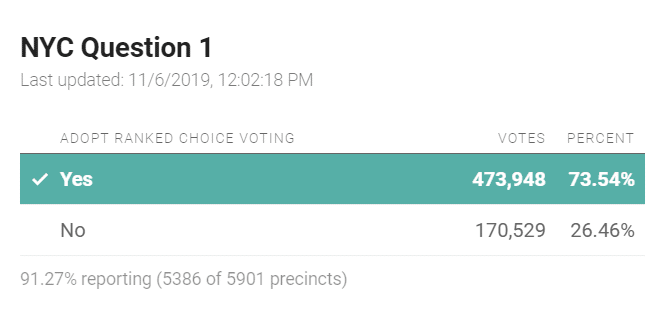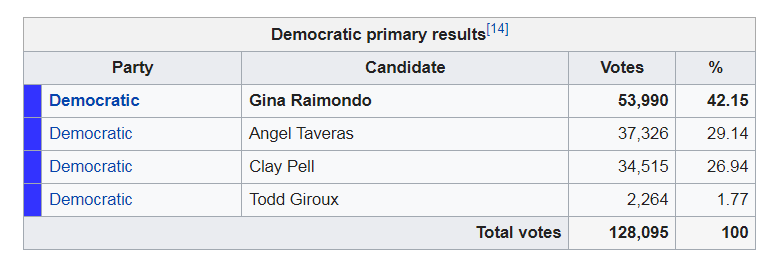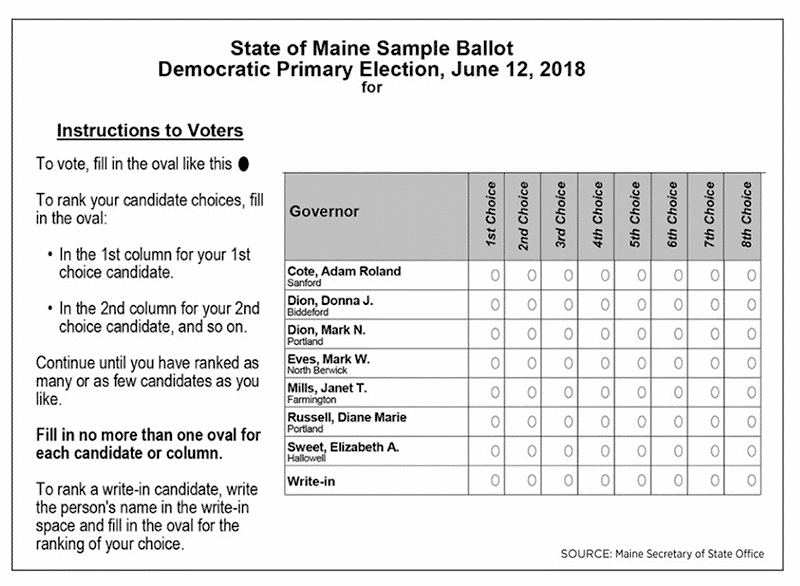NYC voters approve Ranked Choice Voting, is Rhode Island next?
Last night, New Yorkers voted overwhelmingly to implement Ranked Choice Voting (RCV) in America’s largest city. The vote was part of a ballot initiative put to voters and was expected to pass, but the large margin surprised even those advocating for the change. What is Ranked Choice Voting anyway? In a nutshell, it is a voting system designed to eliminate
November 6, 2019, 12:28 pm
By Greg Brailsford
Last night, New Yorkers voted overwhelmingly to implement Ranked Choice Voting (RCV) in America’s largest city. The vote was part of a ballot initiative put to voters and was expected to pass, but the large margin surprised even those advocating for the change.

What is Ranked Choice Voting anyway? In a nutshell, it is a voting system designed to eliminate “spoiler” candidates and give every candidate, especially those not part of the two-party system, a chance to get elected. It works like this: At the ballot box, instead of simply choosing the one candidate you want to win, voters rank the candidates they like for each office in order of preference. If no candidate secures a majority of first-choice votes, an elimination process is triggered and continues until one candidate has majority support.
To help you understand it further, let’s use an example from a past RI gubernatorial election. Here are the actual results of the 2014 RI Democratic primary election for governor.

In this election, Raimondo won with 42.15% of the vote, but the majority of Rhode Islanders did not vote for her. Had either Taveras or Pell dropped out, the results may have been much different. This highlights the problem of the current “choose one” voting system: Voters must often chose the candidate they “think” will win instead of the candidate they want to win, because they fear splitting the vote and the candidate they don’t want at all ends up winning.
Let’s see how this election might have turned out with Ranked Choice Voting. Let’s assume for this example that those who voted for Taveras really did not want Raimondo to win, and would have preferred Pell or Giroux if Taveras was not a candidate. With Ranked Choice Voting, they would enter their preferences on the ballot as:
1. Taveras
2. Pell
3. Giroux
4. [Can be left blank – you do not have to rank every candidate]
With the above ballot, the voter is saying “I want Taveras to win, but if he doesn’t, I’d be OK with Pell. If neither wins, Giroux would be acceptable as my 3rd choice, but I do not want Raimondo at all so I have chosen not to rank her”. This is the great thing about RCV: You can vote for every candidate you would be OK with and leave out those you do not want at all.
Now let’s get to the results…With Ranked Choice Voting, if any candidate gets 50.1% of the vote, they win exactly as they would in our current voting system. A candidate that secures an absolute majority should win, and does win with either system. Where Ranked Choice Voting has the clear advantage is when there is no absolute majority, as with the 2014 Democratic primary above. Assuming for this example that everyone who voted for Taveras ranked their candidates in the order above. Here are the new results of the election:

Let’s explain what happened here: If there is no majority with Ranked Choice Voting, the candidate with the fewest #1 votes (Giroux) is eliminated and those who placed him #1 have their #2 preference counted. For this example, we assume the #2 choice on every Giroux ballot is Taveras (this will not be the case in real elections, but makes it easier to explain). So all the Giroux ballots with Taveras as #2 now get counted as Taveras votes. Do we have a majority yet? No, Giroux’s votes still leave Taveras well short of a 50.1% majority. So then the candidate with the next fewest #1 votes (Pell) is eliminated and his voters have their #2 choice counted. Like Giroux, we’ll assume for this example that Pell’s voters all wanted Taveras as their #2 choice. With Taveras receiving all of Pell’s #2 votes, he jumps ahead and easily secures a majority, winning the governorship.
This result comes much closer to giving voters what they want. It should be noted that the above example was to illustrate how RCV works. In real life, it is probable that Raimondo would have been the #2 choice on some Pell and Taveras ballots, thus making the final totals tighter. But overall, Rhode Islanders would have gotten much closer to who they wanted as governor.
The importance of RCV is further illustrated by a hypothetical example of the 2016 Presidential election. Disregard the Electoral College for a moment and let’s imagine the vote is between Clinton, Trump, and Johnson. Clinton won the popular vote by about 2.6 million votes. But Gary Johnson, the Libertarian candidate, received 4.4 million votes. As Johnson’s politics are a bit closer to Trump’s than Clinton’s, let’s assume a RCV scenario where Johnson voters ranked their preferences as:
- Johnson
- Trump
Johnson ended up 3rd after all ballots were counted. Under RCV, because Johnson got the fewest #1 votes between him, Clinton, and Trump, he is eliminated and those ballots have their #2 preference counted. Since their #2 choice is Trump, all of those Johnson votes convert to Trump, and Trump wins the popular vote, 67,474,169 to 65,853,514. While this is likely not the result most Uprise RI readers would prefer, in this example it awards more voters with the candidate closest to what they want when they don’t get their first preference.
RCV has its critics, but we found most of the criticism to be unfounded. The primary argument against RCV is that it is “not democratic” and the will of the voters is not recognized. But this is categorically untrue. Voters have more of a say with RCV, not less. In 2016, many voters who preferred to vote for the Green Party candidate, Jill Stein, voted for Hillary Clinton knowing that Stein did not have a realistic chance to win. In the history books, those votes were 100% for Clinton, and Stein simply appears as a fringe candidate with virtually no support. With RCV, voters could have made a stand that they prefer Stein, but would accept Clinton. Stein would no longer be a “spoiler” and Clinton likely would have gained votes as a result.
Another similar argument is that voters “become exhausted” and don’t rank every candidate. While exhaustion (for what is typically a 3-5 minute process) is possible, it is more likely that voters who do not rank every candidate simply chose not to, or knew too little about the candidates they did not rank. Again, this is a good thing because it eliminates voters choosing candidates they know nothing about based on whose name sounds more professional or who the incumbent is.

One thing for sure is that leaders of both major parties very much dislike RCV, because it threatens their 2-party duopoly. If outside 3rd party candidates have a realistic shot of winning election, they no longer have to “pay tribute” to the party, change their ideals, and conform to the party’s platform. You can gauge how closely intertwined your local representatives are with party leadership by assessing their enthusiasm for RCV. Our research has found that those who depend on the party for funding, endorsements, etc. are far more critical of RCV than progressive and Libertarian candidates who typically go it on their own.
New York City will most certainly not be the last major city (or state) to enact Ranked Choice Voting. As more voters learn about the concept, it has rapidly grown in popularity. The state of Maine uses RCV in all elections, while the state of NY uses them in all primaries and special elections (After last night, NYC now will use them in all elections). In Rhode Island, leadership in both legislative branches and the current governor have benefited from the current system, and based on an analysis of past election results, all three leaders would likely not be serving their current office with RCV in place. It’s no wonder that RCV bills have not gotten the traction they have elsewhere.
If you like the concept of Ranked Choice Voting and would like to see more fair and democratic elections in RI, the best way to make it happen is to reach out to your state representative and senator, and ask them to sponsor a RCV bill in the next legislative session. For the latest news on Ranked Choice Voting, follow @fairvote on Twitter.






